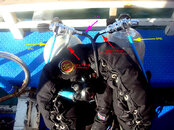glen99
Registered
I recently got a great deal on my local CL on a pair of lp95's with a non isolating manifold. The guy at the local dive shop said that I could dive with my regular singles reg setup and leave the second valve uncovered as long as I did not run it empty and did not open the second valve (obviously). In other words run my primary and secondary off of the same first stage with no reg attached to the second valve. I had no real intention of diving doubles, I dive with my daughter in local quarries so this is not technical or deep diving. I just wanted to verify that this advice is legit. Should I have any concerns about not running a first and second stage off of the second valve? Also, diving doubles do you change the end the dive at 500 psi rule to end the dive at 250-300 psi because you have two tanks?
This is the setup
2 faber lp 95's
highland millworks bands
dive rite valves, set up for yolk (not sure of they are inserts or not)
non isolating manifold (not sure of brand, but the finish is the same as the valves
steel backplate
60 lb wing
Thanks
This is the setup
2 faber lp 95's
highland millworks bands
dive rite valves, set up for yolk (not sure of they are inserts or not)
non isolating manifold (not sure of brand, but the finish is the same as the valves
steel backplate
60 lb wing
Thanks






